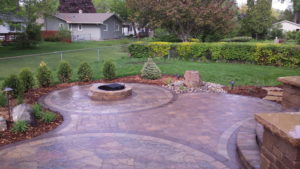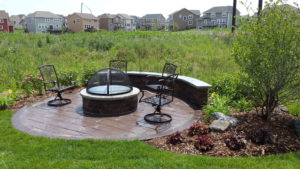Starting the Process of a Successful Outdoor Fireplace or Fire Pit Project
So you’re considering the installation of an outdoor fireplace or fire pit. While portable patio heaters serve a purpose, there’s nothing that compares to the ambiance of these built-in or freestanding features. Another benefit, it will boost your home’s resale value.
Just like any other big decisions, ask yourself some basic questions prior to implementation.
Have I checked with City officials about applicable codes and ordinances?
First and foremost, before getting too far along with the design process, check with your city’s planning office for applicable codes and required building permits. Regulations will dictate where a fire pit or fireplace can be located relative to existing structures and your property line. Outdoor features must meet fire standards for your location.
[While you’re checking things out, it never hurts to touch base with your insurance agent to understand any potential impact a fireplace or fire pit may have on your coverage.]
Have I considered various options for location?
Now it’s time to determine the location. Remember, placement is key in determining how often your fire pit or fireplace is used.
Fireplace:
- For a small fireplace, plan on the installation of a 12 X 12 foot patio and an 18 X 18 foot patio for a large fireplace. You’ll want to ensure plenty of space for furniture or built-in patio seating.
- Whenever possible, choose a location where the fireplace will act as a windbreak.
- A fireplace can be a great looking privacy screen between you and your neighbors.
- Pick an area that won’t block scenic views.
- Choose an area where the fireplace will never be a safety hazard to the house or nearby structures – ensure proper ventilation and protection from fires started by sparks.
- Confirm proper drainage so there isn’t damage from standing water.
Fire pits:
- Set fire pits upon natural surfaces such as concrete, stone, brick, slate, gravel, or a fire-resistant composite.
- To maximize usage, consider installation of outdoor lighting.
- For smaller yards, a fire bowl is a good option – when building a large fire pit, square or rectangular designs work well.
- Fire pits should be located far enough away from anything that may catch fire (structures, plants, etc.)
- It’s best to place a fire pit near outdoor kitchens, pools, and patios where people are already gathering.
Should I choose a wood burning or gas-fueled fire feature?
Budget-wise, a gas-fueled feature tends to cost more than a wood burning one. The greater distance from the house the gas line runs, the more expensive it will likely be.
Because a wood burning fireplace or fire pit doesn’t require utility connections, they can be constructed in a greater variety of locations. They also are less expensive to operate than gas-fueled features. However, if you’re not the lumberjack type, chopping wood is not as convenient as flicking a switch.

In summary, adding an outdoor fireplace or fire pit is a job that requires proper planning. By answering a few questions before designing the project, you’ll eliminate the headaches of ending up with an outdoor feature that doesn’t meet your needs.
If you have questions, we have the answers. Contact us today for a free consultation. 651.755.7901
